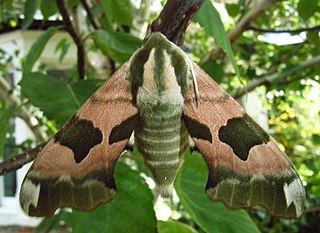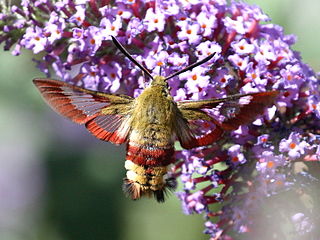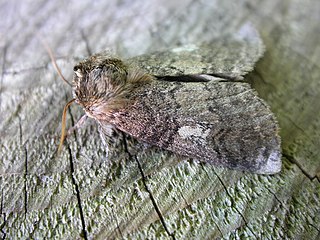
The swallow-tailed moth is a moth of the family Geometridae. The species was first described by Carl Linnaeus in his 1758 10th edition of Systema Naturae. It is a common species across Europe and the Near East.

The bordered white or pine looper, is a moth of the family Geometridae. Among these, it belongs to tribe Bupalini of the subfamily Ennominae. B. piniaria is a common species throughout the western Palearctic region, the Near East and North Africa. However, its presence in certain regions – e.g. the northern Balkans – is doubtful.

Mimas tiliae, the lime hawk-moth, is a moth of the family Sphingidae. It is found throughout the Palearctic region and the Near East, and in northern Spain (Europe). The species was first described by Carl Linnaeus in his 1758 10th edition of Systema Naturae.

Smerinthus jamaicensis, the twin-spotted sphinx, is a moth of the family Sphingidae. The species was first described by Dru Drury in 1773.

Smerinthus ocellatus, the eyed hawk-moth, is a European moth of the family Sphingidae. The species was first described by Carl Linnaeus in his 1758 10th edition of Systema Naturae.

The orange swift or orange moth is a moth belonging to the family Hepialidae. The species was first described by Carl Linnaeus in 1761 and was previously placed in the genus Hepialus. It is distributed throughout Europe.

Hemaris tityus, the narrow-bordered bee hawk-moth, is a moth of the family Sphingidae which is native to the Palearctic.

Zygaena trifolii, the five-spot burnet, is a day-flying moth in the family Zygaenidae found in North Africa and Europe. It was described by the German zoologist Eugenius Johann Christoph Esper in 1783 from the type specimen found in Frankfurt am Main, Germany.

Abraxas sylvata, the clouded magpie, is a Palearctic moth of the family Geometridae that was named by Giovanni Antonio Scopoli in 1763.

Oncocera semirubella, the rosy-striped knot-horn, is a small moth of the family Pyralidae.

Hemaris fuciformis, known as the broad-bordered bee hawk-moth, is a moth of the family Sphingidae.

Deilephila porcellus, the small elephant hawk-moth, is a moth of the family Sphingidae. The species was first described by Carl Linnaeus in his 1758 10th edition of Systema Naturae.

Poecilocampa populi, the December moth, is a moth of the family Lasiocampidae.

Tethea or, the poplar lutestring, is a moth of the family Drepanidae. It was first described by Michael Denis and Ignaz Schiffermüller in 1775. The species can be found in Europe, northern and eastern Asia and Japan. The imago resembles Tethea ocularis.

Penthophera morio is a moth species of subfamily Lymantriinae first described by Carl Linnaeus in 1767.

Cosmotriche is a genus of moths in the family Lasiocampidae. The genus was erected by Jacob Hübner in 1820.

Izatha metadelta is a moth of the family Oecophoridae. It is endemic to New Zealand, where it is known from the North Island only. It is rare north of Waikato and the Bay of Plenty.
Agdistopis sinhala is a moth of the family Macropiratidae. It is found in south-east Asia, including Sri Lanka, India, Japan and Taiwan.

Ichneutica paraxysta is a moth of the family Noctuidae. It is endemic to New Zealand. This species is very similar in appearance to its close relative I. acontistis but as the range of the two species do not overlap this is unlikely to cause confusion. I. paraxysta is only found in the North Island at the subalpine zones in the Mount Taranaki region and at Mount Ruapehu. It prefers tussock grassland and shrubland habitat. The life history of this species is unknown as are the host species of its larvae however it has been hypothesised that the larval host plants are species in the genera of Poa and Festuca.
This page is based on this
Wikipedia article Text is available under the
CC BY-SA 4.0 license; additional terms may apply.
Images, videos and audio are available under their respective licenses.




















